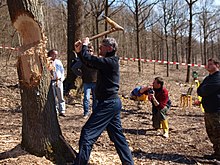

Experimental archaeology (also called experiment archaeology) is a field of study which attempts to generate and test archaeological hypotheses, usually by replicating or approximating the feasibility of ancient cultures performing various tasks or feats. It employs a number of methods, techniques, analyses, and approaches, based upon archaeological source material such as ancient structures or artifacts.[1]
It is distinct from uses of primitive technology without any concern for archaeological or historical study. Living history and historical reenactment, which are generally undertaken as hobbies, are non-archaeological counterparts of this academic discipline.
One of the main forms of experimental archaeology is the creation of copies of historical structures using only historically accurate technologies. This is sometimes known as reconstruction archaeology or reconstructional archaeology; however, reconstruction implies an exact replica of the past, when it is in fact just one person's idea of the past; the more archaeologically correct term is a working construction of the past. In recent years, experimental archaeology has been featured in several television productions, such as BBC's "Building the Impossible"[2] and the PBS's Secrets of Lost Empires.[3] Most notable were the attempts to create several of Leonardo da Vinci's designs from his sketchbooks, such as his 15th century armed fighting vehicle.
- ^ Experimental archaeology is "Within the context of a controllable imitative experiment to replicate past phenomena in order to generate and test hypotheses to provide or enhance analogies for archaeological interpretation" (Mathieu, 12)
- ^ "Building the Impossible" – via www.imdb.com.
- ^ "NOVA Online – Secrets of Lost Empires". www.pbs.org.